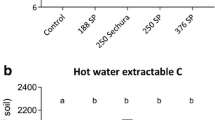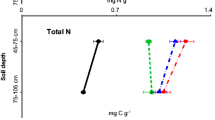Abstract
We investigated the quantity and distribution of organic C, microbial biomass C, protease, arylsulphatase and arylphosphatase activity, and earthworm numbers and biomass in the soil from a 37-year-old grazed pasture supplied with superphosphate at rates of 0, 188, and 376 kg ha-1 annually. The results were compared with a non-irrigated wilderness site which had not been used for agriculture and an arable site that had been intensively cultivated for 11 consecutive years. In the 0- to 5-cm layer, organic C followed the trend arable<wilderness = control<low phosphate = high posphate and soil biological activity generally followed a similar trend. For example, protease and arylsulphatase activity and microbial biomass C followed the order arable<wilderness<control<low phosphate = high phosphate. The greater activity in the control than the wilderness site was attributed to the more regular turnover of organic matter throughout the year in the control due to the activity of the grazing animals. Earthworm numbers increased in the order arable<wilderness<control<low phosphate<high phosphate. In the improved pasture sites the earthworm population was dominated by Aporrectodea caliginosa (77–89% of total numbers) although Lumbricus rubellus made an increasing contribution to the population with increasing superphosphate rates. In the unirrigated wilderness site the population consisted of 56% A. caliginosa and 44% L. rubellus. While Octolasion cyaneum and A. rosea made up a small proportion of the population in the improved pasture sites, they were not present in the wilderness or arable sites. A. caliginosa was the only species present in the arable site. The mean fresh weight of individuals followed the order arable<control = low phosphate = high phosphate<wilderness and the proportion of jeveniles in the population was greatest in the arable and lowest in the wilderness site.
Similar content being viewed by others
References
Blakemore LC, Searle PL, Daly BK (1972) Methods of chemical analysis in soils. Soil Bur Bull 10A, New Zealand Soil Bureau, Wellington
Edwards CA (1983) Earthworm ecology in cultivated soils. In: Satchell JE (ed) Earthworm ecology. Chapman and Hall, London, pp 123–137
Edwards CA, Lofty JR (1977) Biology of earthworms. Chapman and Hall, London
Edwards CA, Lofty JR (1982) The effect of direct drilling and minimal cultivation on earthworm populations. J Appl Ecol 19:723–734
Fieldes M (1968) General survey of the soils of the South Island, New Zealand. Soil Bur Bull 27, New Zealand Soil Bureau, Wellington
Haynes RJ, Swift RS (1988) Effects of lime and phosphate additions on changes in enzyme activities, microbial biomass and levels of extractable nitrogen, sulphur and phosphorus in an acid soil. Biol Fertil Soils 6:153–158
Haynes RJ, Williams PH (1992a) Accumulation of soil organic matter and the forms, mineralisation potential and plant-availability of accumulated organic sulphur: Effects of pasture improvement and intensive cultivation. Soil Biol Biochem 24:209–217
Haynes RJ, Williams PH (1992b) Long-term effect of superphosphate on accumulation of soil phosphorus and exchangeable cations on a grazed, irrigated pasture site. Plant and Soil 142:123–133
Ladd JN (1985) Soil enzymes. In: Vaughn D, Malcolm RE (eds) Soil organic matter and biological activity. Martinus Nijhoff, The Hague, pp 175–221
Ladd JN, Butler JHA (1972) Short-term assays of soil proteolytic enzymes using proteins and dipeptide derivatives as substrates. Soil Biol Biochem 15:251–256
Lee KE (1959) The earthworm fauna of New Zealand. Bull 130, NZ Dep Sci Ind Res, Wellington
Lee KE (1985) Earthworms: Their ecology and relationships with soils and land use. Academic Press, London
Lofs-Holman A (1983) Earthworm population dynamics in different agricultural rotations. In: Satchell JE (ed) Earthworm ecology. Chapman and Hall, London
Martin NA (1977) Guide to the lumbricid earthworms of New Zealand pastures. NZ J Exp Agric 5:301–309
Nguyen ML, Rickard DS, McBride SD (1989) Pasture production and changes in phosphorus and sulphur status in irrigated pastures receiving long-term applications of superphosphate fertiliser. NZ J Agric Res 32:245–262
Sears PD (1949) Soil fertility and pasture growth. Sheep Farm Annu, NZ Sovt, Wellington, pp 1–19
Sears PD, Evans LT (1953) Pasture growth and soil fertility. III. The influence of red and white clovers, superphosphate, lime and dung and urine on soil composition and on earthworm and grass grub populations. NZ J Sci Tech 35A:42–52
Sims RW, Gerard BM (1985) Earthworms. Synopses of British fauna No 31, Linean Society, London
Sparling GP (1985) The soil biomass. In: Vaughn D, Malcolm RE (eds) Soil organic matter and biological activity. Martinus Nijhoff, The Hague, pp 223–262
Speir TW, Ross DJ (1975) Effects of storage on the activities of protease, urease, phosphatase and sulphatase in three soils under pasture. NZ J Sci 18:231–237
Speir TW, Ross DJ (1978) Soil phosphatase and sulphatase. In: Burns RG (ed) Soil enzymes. Academic Press, London, pp 197–250
Syers JK, Springett JA (1984) Earthworms and soil fertility. Plant and Soil 76:93–104
Vance ED, Brooks PC, Jenkinson DS (1987). An extraction method for measuring soil microbial biomass C. Soil Biol Biochem 17:703–707
Waters RAS (1955) Numbers and weights of earthworms under a highly productive pasture. NZ J Sci Tech A36:516–525
Watkin BR, Wheeler JL (1966) Some factors affecting earthworm populations under pasture. J Br Grassl Soc 21:14–20
Williams PH, Haynes RJ (1990) Influence of improved pastures and grazing animals on nutrient cycling within New Zealand soils. NZ J Ecol 14:49–57
Author information
Authors and Affiliations
Rights and permissions
About this article
Cite this article
Fraser, P.M., Haynes, R.J. & Williams, P.H. Effects of pasture improvement and intensive cultivation on microbial biomass, enzyme activities, and composition and size of earthworm populations. Biol Fertil Soils 17, 185–190 (1994). https://doi.org/10.1007/BF00336320
Received:
Issue Date:
DOI: https://doi.org/10.1007/BF00336320




